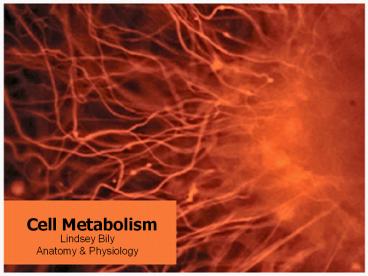Cell Metabolism - PowerPoint PPT Presentation
1 / 24
Title:
Cell Metabolism
Description:
Lindsey Bily Anatomy & Physiology Metabolism All the reactions that occur in the body Cell Metabolism is all the reactions that occur in the cell. – PowerPoint PPT presentation
Number of Views:395
Avg rating:3.0/5.0
Title: Cell Metabolism
1
Cell Metabolism
- Lindsey Bily
- Anatomy Physiology
2
Metabolism
- All the reactions that occur in the body
- Cell Metabolism is all the reactions that occur
in the cell.
3
Metabolic Pathways
- Sequence of cell reactions.
- Catabolism or a catabolic pathway net effect is
to break down large molecules into smaller ones. - Produce energy
- Anabolism or anabolic pathway net effect is to
build large, complex molecules from smaller ones.
- Require energy
4
(No Transcript)
5
Catabolism
6
Anabolism
7
Enzymes
- Tertiary or quarternary structured functional
proteins (from Ch. 2) - At our body temperature, the activation energy
required to carry on most reactions is too great.
- Enzymes LOWER the activation energy of a chemical
reaction (catalysts).
8
Enzymes
- Lower the activation energy of a reaction.
9
How Enzymes Work
- Enzymes have an active site. That is what fits
into their substrate. - Lock and Key Model
10
Enzymes Regulate Metabolic Pathways
- If an enzyme is inactivated turned off the
entire metabolic pathway can be stopped. - Enzymes are specific to their substrate. Each
pathway requires specific enzymes in order to
work.
11
Enzymatic Disorders
- May occur because a gene is mutated so the enzyme
is dysfunctional or missing altogether. - Tay Sachs
- Morquios Syndrome (Simon Birch)
12
Allosteric Effect
- Allosteric Changing a 3D Shape.
- Allosteric Effectors change the shape of the
enzyme to either activate or inactivate it. - pH, temperature, antibiotics, coenzymes
13
Allosteric Effect of Hemoglobin
- Each molecule of hemoglobin can bind to 4 oxygen
molecules. - When one oxygen molecule binds to the Iron in the
Heme group in each polypeptide chain, it changes
the entire shape of the hemoglobin molecule
making it better at binding more oxygen
molecules. - Hydrogen and Carbon Dioxide promote the release
of oxygen by favoring the deoxygenated shape of
hemoglobin, thereby causing the release of
oxygen. - Hydrogen and Carbon Dioxide are in high
quantities by actively metabolizing tissues.
14
Allosteric Effect of Hemoglobin
15
End Product Inhibition
- Negative Feedback
- A product of the metabolic pathway will bind to
the allosteric site of an enzyme inactivating it
and turning off the entire pathway.
16
Allosteric Effect
17
Catabolic Pathways
- Cellular Respiration breakdown of glucose into
CO2 and H2O. A lot of potential energy is
released from the breaking of the bonds into heat
and ATP. - 3 steps
- 1. glycolysis
- 2. Citric Acid Cycle
- 3. Electron Transport System
18
Glycolysis- 1ST STEP
- Begins with glucose ( 6 Carbons) and ends with
pyruvic acid (3 carbons). - Glycolysis literally means breaking glucose.
- Occurs in the cytosol of the cell.
- Does not require oxygen so it is anaerobic.
- The energy released either transferred to ATP or
NADH. - Once pyruvic acid is made, if oxygen is present,
it will enter the Citric Acid Cycle. If no oxygen
is present, it will continue on to form lactic
acid.
19
ATP Production
- Glycolysis yields only 2 ATP!! Not a lot at all.
- We need more!!
20
(No Transcript)
21
Citric Acid (Krebs) Cycle
- If oxygen is present, pyruvic acid moves into the
mitochondria. - Now you can tell your friends why it is called
the Powerhouse of the Cell! Arent you excited?
22
Citric Acid Cycle
- A series of chemical reactions.
- Creates a little ATP, but mostly energizes
electrons that attach to coenzymes.
23
Electron Transport Chain
- The energized electrons and protons move to the
Electron Transport Chain. - They are then formed into energy (ATP) and water.
- ETS makes 34 ATP!
24
Cellular Respiration Produces 36 ATP































